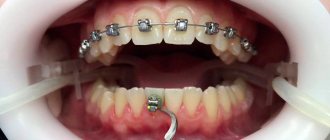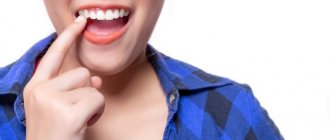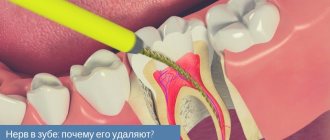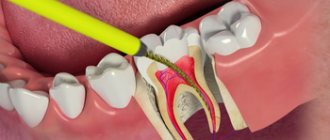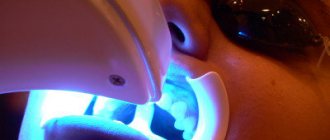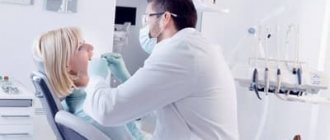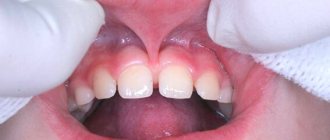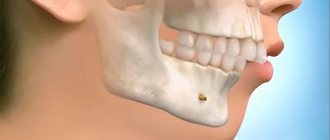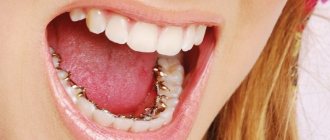Installation of braces – this is only the beginning of treatment, the main thing happens after. For effective treatment, periodic tightening of the braces, or rather the arch, and even its replacement is necessary. At the initial stage orthodontic treatment
thinner and more elastic arcs are used for delicate effects, which in the next stages are changed to more rigid and durable ones.
It is this process, the activation of braces
, that ultimately helps change the position of the teeth to the correct one.
Attention! Braces are tightened by the same orthodontist who initially installed the braces. It is not recommended to change specialist. The entire treatment process must be carried out under the strict supervision of one orthodontist.
What are braces
Braces are a non-removable orthodontic structure for the correction of developmental defects of the dentofacial apparatus. The bracket system consists of two main parts and fastening elements:
- • bracket plates attached using an adhesive composition to tooth enamel; • guiding power arc, which creates mechanical pressure on the teeth; • fasteners: ligatures (rubber rings or metal wire) or miniature locks. If ligatures are used, then the braces are called ligature. If the clasps are ligature-free (self-ligating).
Installation of veneers
Veneers are porcelain or composite plates that replace the outer thin layer of a tooth.
Effectively correct dental discoloration, cover cracks or stains due to enamel hypoplasia. Veneers are an aesthetic solution and do not replace orthodontic treatment. Unlike veneers, braces move teeth. Treatment with braces ensures the formation of an aesthetically correct smile, restoration of the physiological bite and function of the dental system. The material is for informational purposes only and is presented for informational purposes. It does not replace consultation with an orthodontist and is not a guide to correcting dental anomalies.
Indications for treatment with braces
Like any treatment, indications for orthodontic therapy must be determined by a doctor. Installation of braces is indicated if the following conditions exist:
- malocclusion when the dentofacial apparatus is formed;
- occlusion defects that appear during the period of mixed dentition;
- deviations from the correct growth vector of individual dental elements;
- in preparation for prosthetics (classical or implantation) if tooth extraction causes the remaining elements to shift to the vacant space;
- crowding or, on the contrary, gaps between teeth (diastemas and trema);
- tilting the dental elements forward or backward;
- micrognathia (reduced jaw size).
Sometimes the disorders are clearly expressed, but often only a specialist can notice the pathology. Contacting an orthodontist is necessary in order to promptly identify an anomaly in the development of the dental system and eliminate it.
What is the bite like?
Occlusion - the position of the upper and lower dentition in the position of central occlusion. All types of bite can be divided into physiological and pathological.
Physiological:
- Orthognathic is the “ideal” variant of the bite, which is characterized by tight contacts between the teeth and dentition, as well as overlapping of the lower dentition by 1/3 of the crown;
- Biprognathic - a bite in which the crowns of the teeth are directed towards the vestibule of the mouth;
- Progenic – a bite characterized by a slight protrusion of the lower jaw forward;
- Direct - a type of bite in which, in the position of central occlusion, the upper and lower dentition touch the cutting edges.
These types of occlusion are allowed as variants of the norm of mutual arrangement of the dentition, since they are not capable of leading to functional disorders of the dentoalveolar system.
Pathological:
- Mesial – a bite characterized by protrusion of the lower jaw forward;
- Distal - a bite in which the upper jaw is more massive than the lower jaw;
- Deep - a bite in which the upper teeth strongly overlap the lower ones;
- Crossbite - a bite in which individual teeth of the lower jaw overlap the upper teeth in a separate area;
- An open bite is a bite in which gaps are formed between the closed teeth.
Pathological types of occlusion cause functional disorders in the dental system, and also, in some cases, disrupt the aesthetics of a smile.
Only an experienced orthodontist can most accurately determine the type of bite and draw up a treatment plan. Request an appointment in Moscow with Irina Aleksandrovna Butorina. The specialist has many years of experience, as well as more than a thousand satisfied patients.
Contraindications for installing braces
Even if there are indications for orthodontic correction using a brace system, it happens that such therapy may be contraindicated for a particular patient. Prohibitions are divided into relative and absolute. Relative restrictions include those that are temporary, for example, the acute course of a disease.
Relative contraindications:
- periodontal diseases;
- dental diseases (caries, pulpitis, etc.);
- pregnancy;
- bruxism.
Absolute contraindications:
- partial edentia (absence of a large number of teeth);
- oncology;
- osteoporosis and other bone diseases;
- mental illness;
- endocrine diseases;
- HIV AIDS;
- tuberculosis.
How often is activation required?
The recommended frequency of visits to the orthodontist to monitor and replace elements of the braces system is approximately once a month. This is suitable for classic ligature systems with elastic connecting parts. The procedure requires a responsible attitude, otherwise the established time frame for wearing braces may increase significantly. Some clinics have even introduced fines for missing activation without a good reason. In addition, timely replacement of rubber ligatures is a good prevention of caries, which can develop under them if they are attached to the tooth for a long time.
When wearing self-ligating systems, visits to the dentist are required less often, but are nevertheless just as mandatory. Remember, the effectiveness of bite correction using braces depends on the joint efforts of the doctor and the patient. The orthodontist will schedule your next visit during your current examination. Activation of the system is a paid service, and the price of replacing elements depends on the complexity and cost of the orthodontic structure itself.
Types of bracket systems
In dentistry, bracket systems are usually divided into types depending on the main classifying characteristics: location on the dental rows, material of manufacture, presence of ligatures.
Depending on the place of fixation, braces are:
• vestibular – installed on the outer surface of the dentition; • lingual – attached to the teeth from the tongue side.
Depending on the material of manufacture:
- • metal; • ceramic; • sapphire; • combined.
Depending on the method of fixing the power arc on the bracket plates:
- • ligature, i.e. with fastening by means of ligatures (fastening parts in the form of rubber rings or metal wire); • non-ligating (self-ligating). In this case, the guide arc is fixed with small locks.
Excursion into history
At the beginning of the 20th century, the American doctor Edward Engle created the first prototype of the braces system and called it the Engle apparatus. Angle's apparatus consisted of an elastic stainless steel arc and ligature elements. The arc was tightly fixed in the tubes. The tubes were soldered to orthodontic rings placed on the first molars. Each tooth was tied to an arch curved in the shape of the dentition with a ligature wire.
Subsequently, the scientist significantly changed the original design and developed the edgewise technique. Orthodontic locks, edgewise, were a rectangular piece with a groove. An arc was inserted into the groove and the lock was locked with a pin. Subsequently, the design of braces was modified: orthodontic arches with a square and rectangular cross-section profile, with sharp and rounded edges, appeared.
Later, the edgewise technique was further modified by doctors. Thanks to the active development of orthodontics in the 20th century, the modern operating principle of braces was formed. Today, the doctor is offered various options for torque and angulation. Torque (or inclination) is the deviation of a tooth from its axis in the vestibulo-oral direction. Angulation is the deviation of the tooth in the mesio-distal direction. Taking into account torque and angulation allows, based on a specific clinical case, to individually select the optimal brace option for each tooth.
Treatment algorithm
Therapy with braces is carried out in compliance with a specific protocol. Let's look at it step by step:
- diagnostics – identifying indications and contraindications, conducting hardware research to determine the complexity and characteristics of a specific clinical case. Performing an orthopantomogram (panoramic image), teleroentgenogram (x-ray image from a remote distance), as well as images in frontal, lateral and axial projection;
- taking dental impressions;
- drawing up a treatment plan;
- preparation for treatment - elimination of caries and inflammation of the oral cavity, professional teeth cleaning to remove soft plaque and hard deposits;
- fixing the finished brace system in the patient’s mouth;
- process of therapeutic influence (movement of dental elements). The duration of therapy depends on the individual and may last up to 24 months or longer. During treatment, the patient should regularly visit the orthodontist to adjust the position of the power guide arc;
- removal of braces upon achievement of results;
- wearing retention devices to consolidate the correction result. The duration of this stage is determined by the attending physician.
Teeth hurt after braces tightening
We hasten to reassure you: this is natural and normal, because the pressure increases, and some discomfort, as at the very beginning, after installing braces, is inevitable. However, you should immediately tell your doctor about severe pain - constant discomfort that does not go away the next day after the tightening cannot be felt. You don’t have to endure it if the wire of the braces interferes with you and you touch it with your gums or tongue.
Dentist advice:
Before the braces tightening procedure, it is better to think through your diet in advance for a day or two in advance - exclude food that needs to be chewed vigorously and leave something simpler, soft food (yogurt, cereal, puree);- It is better to eat and brush your teeth before the procedure - afterward, due to the sensitivity of the teeth, it will be more difficult;
- Talk to your doctor about what type of pain medication you can take if the pain bothers you. Important: do not take painkillers or anti-inflammatory drugs on an empty stomach;
- After meals, you can (and even should) use an antibacterial mouth rinse.
Why is it important to choose the right orthodontist?
Orthodontic treatment is long-term, it will last from a year or more, so the patient cannot immediately determine whether it is being treated well or not. If something in the treatment goes wrong due to the doctor’s fault, you will find out about it months, or maybe years, later. In order not to waste time, money, nerves and health, it is important to immediately choose a good orthodontist with whom you will also enjoy communicating for a long time. If you want to know our recommendations on how to do this so as not to regret it, read the article: “How and why to choose an orthodontist?”
It is important to change the arc on time
At each stage of treatment you need to get a certain result. Once it is reached and the teeth have assumed their new position, the archwire no longer works. And if you often postpone doctor's appointments, each week of delay prolongs the entire treatment.
Wearing one archwire for too long does not harm your teeth, but it does not make sense.
Treatment by an orthodontist requires self-discipline. Be prepared to adjust your schedule around your doctor's appointments. And remember that all this is done for the sake of health and a beautiful smile. And this is the best incentive!
